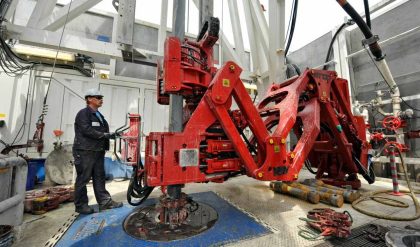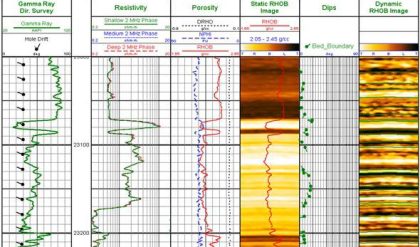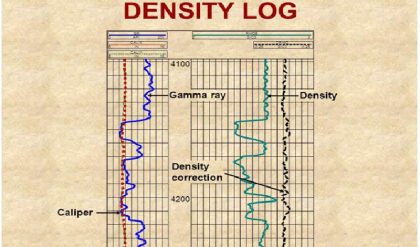Petroleum applications of acoustic-wave-propagation theory and physics include both:
· Surface-geophysical methods
· Borehole-geophysical methods
Acoustic logging is a subset of borehole-geophysical acoustic techniques.
Historically, the primary and the most routine uses of acoustic logs in reservoir engineering have been:
· Porosity determination
· Identification of gas-bearing intervals
· Cement evaluation
Continuing developments in tool hardware and in interpretation techniques have expanded the utility of these logs in formation evaluation and completion (fracture) design and evaluation.
Overview
A virtual explosion in the volume of acoustic research conducted over the past 20 years has resulted in significant advances in the fundamental understanding of downhole acoustic measurements. These advances, in turn, have greatly influenced practical logging technology by allowing logging-tool designs to be optimized for specific applications.
Acoustic-wave data-acquisition methods cover a broad range of scales from millimeters to hundreds of meters (Fig. 1[2]). Table 1 lists other common surface- and borehole-geophysical methods.

Fig. 1 – Diagram showing the maximum and minimum ranges vs. the resolution for various acoustic methods.[2] Acoustic logging includes the sonic and ultrasonic ranges (courtesy of SPE).

Table 1
Borehole acoustic-logging measurements are used in a wide variety of geophysical, geological, and engineering applications and play an important role in the following undertakings (Table 2):
· Evaluating reservoirs
· Reducing exploration and production risks
· Selecting well locations
· Designing completions
· Increasing hydrocarbon recovery

Table 2
Modern logging tools include conventional borehole-compensated (BHC) monopole devices as well as the newer array devices—both monopole and multipole (monopole/dipole)—and logging-while-drilling (LWD) acoustic services. These logging tools provide acoustic measurements in all borehole mud types (but not in air- or foam-filled boreholes) in vertical, deviated, and horizontal wells, in both open and cased hole. They are combinable with other logging devices and are available in a variety of sizes to accommodate a range of borehole and casing diameters. Specialized tool designs are used for cement and casing evaluation and borehole imaging.
Geophysical applications
The higher operating frequency of acoustic-logging tools and the smaller TR distances allows for higher-quality velocity data and finer vertical resolution than surface reflection techniques. Acoustic-velocity logs were originally developed for calibrating surface seismic velocities and reflectors. Acoustic-log interval travel time or transit time, Δt, can be summed, i.e., integrated, over the entire logged interval to provide the equivalent of seismic one-way time which is compared to borehole seismic surveys and reflection seismic two-way time.
Acoustic-log data are commonly calibrated using checkshot (velocity) or vertical seismic profile (VSP) surveys prior to use in geophysical applications. Data from these surveys, which use downhole receivers and surface acoustic sources, are used to adjust the log data for drift and borehole conditions and result in improved time-depth correlation. Acoustic-log data are combined with density-log data, to generate an impedance log that in turn is used to produce a synthetic seismogram. Synthetic seismograms are artificial seismic records that tie seismic time to log depth and are also used to match well-log quantities to seismic attributes for distinguishing primary seismic events (geologic structure and stratigraphy). It is possible, however, that a synthetic seismogram may not provide a very good match to the seismic field data. Disagreements commonly result from the differences scale and acquisition physics used in seismic and well-log measurement; for example:
1. Operational frequency (wavelength)
2. Borehole condition
3. Angle of measurement (particularly in the presence of anisotropy)
Acoustic-log data provide a fundamental and essential element of modern seismic reservoir characterization.[8] See fundamentals of geophysics for more information on the determination and use of these types of analyses.
Near-well imaging
Acoustic data acquired using modern array tools can provide high-resolution (0.5 m), microscale “seismic” 2D and 3D images of structural features in the near-borehole region (10 to 15 m). Conventional seismic-processing techniques, including filtering and migration, are used to extract compressional and shear reflections from the acoustic data. The reflections are then used to image geological features near the borehole. This technique allows the imaging of (Fig. 2):
· Bed boundaries
· Thin beds (stringers)
· Fractures
· Faults in openhole and cased wells

Fig. 2 – Near-well acoustic image of a fractured reservoir using direct (compressional) (right panel) and converted (shear) (left panel) acoustic modes. The fractures indicated in the converted mode data are more apparent than in the direct data and also correlate better with fractures seen on the televiewer image[2] (not shown) (courtesy of SPE).
Acoustic theory and wave propagation
The principles of borehole acoustic logging (and surface seismic methods) are based on the theory of wave propagation in an elastic medium, as detailed in several sources[18][19][20][13]. The oscillating motion generated by a sound source (transducer) in an elastic medium (rock formation) is called an elastic wave or acoustic wave (also called head or body waves). Wave theory predicts how an acoustic signal propagates through the borehole and formation. Snell’s law explains how the acoustic signal behaves at the velocity boundary separating the borehole and the formation, that is, how it is transmitted into the formation and back to the receivers. Elasticity is the property of matter that causes it to resist deformation in volume or shape. It is the elastic nature of rock formations that permits wave propagation. Acoustic waves have four measurable properties:
· Velocity
· Amplitude
· Amplitude attenuation
· Frequency
Acoustic logging tools are designed to measure one or more of these properties, with velocity (slowness) being the most common.
The waveform recorded at the logging tool’s receivers is a composite signal containing different energy modes, each with a different frequency, velocity, and amplitude. For borehole logging, the modes of primary interest (Fig. 3) are, in order of arrival:
· Compressional
· Shear
· Stoneley (tube) waves
The waveform is recorded as acoustic amplitude as a function of time.

Fig. 3 – Generalized acoustic waveform showing the wave signature of different energy modes (courtesy of Baker Atlas).
These waves are transmitted through the medium some distance from the origin of displacement. The particles of the medium do not travel with the wave, but only vibrate around their mean central position. Acoustic waves are classified according to the direction of particle displacement with respect to the direction of wave propagation as either:
· Longitudinal (i.e., particle displacement is parallel to the direction of propagation)
· Transverse (i.e., direction of particle displacement is perpendicular to the direction of propagation)
In acoustic logging:
· The longitudinal wave is known as the compressional wave
· The transverse wave is known as the shear wave
The presence of the borehole excites two additional acoustic energy modes, called guided waves:
· Normal (pseudo-Rayleigh)
· Tube (Stoneley) waves
Acoustic-wave velocity is controlled by a number of factors:
· Lithology (mineralogy)
· Cementation
· Clay content
· Texture
· Porosity
· Pore-fluid composition and saturation
· Overburden-and pore-fluid pressure (stress)
· Temperature
The rock’s mechanical properties, elastic dynamics, and density are a constant for a particular homogeneous and isotropic material. Acoustic-wave velocity can be related to rock elastic properties through three constants of:
· Proportionality
· Elastic moduli (e.g., Young’s, shear, and bulk)
· Poisson’s ratio
This serves as the basis for mechanical-property evaluation by acoustic logs. In reality, most petroleum reservoirs contain varying pore sizes, pore fill (e.g., clays), fractures, etc. and consequently, are neither truly isotropic nor homogeneous. Furthermore, in fluid-saturated rocks, these acoustic properties also depend on the type and volume of fluids present.
Compressional waves
Compressional (P, primary, or pressure) waves are longitudinal waves that are transmitted through an elastic formation by compression or pressure. Particle motion is parallel to the direction of wave propagation (Fig. 4). They can travel through solids, liquids, and gases and are the fastest wave type—they represent the acoustic first arrival. Of all acoustic wave types, they are the most reliable because they are least affected by:
· Faults
· Unconsolidated formations
· Borehole fluids
The wave is transmitted by both the rock matrix (i.e., the framework) and the fluid present in the pore throats. A compression, together with an adjacent rarefaction preceding or following it, constitutes a complete cycle. The distance between complete cycles is called the wave length and the number of cycles propagating through a point in the medium per unit time is the frequency. The velocity of elastic-wave propagation in an isotropic homogeneous medium can be derived from a combination of the theory of elasticity with Newton’s law of motion. Compressional-wave velocity (or travel time) is a function of the density and elasticity of the medium and is a constant for a given material.

Fig. 4 – Direction of particle motion in compressional and shear waves and wave motion generated by monopole and dipole transmitters (courtesy of Baker Atlas).
Shear and borehole flexural waves
Shear (S, secondary) waves are transverse waves that are transmitted by lateral displacement of particles in a rigid elastic formation. Particle motion is perpendicular to the direction of motion (Fig. 4). Normally, shear waves are the second arrival in an acoustic wave train. In most reservoir rocks, shear waves generally have higher amplitudes than compressional waves but lower velocities, by as much 40 to 50%. There are two types of borehole shear waves—direct and indirect, also known as refracted or induced. Indirect shear waves are induced in a formation through a process known as mode conversion in which some of the compressional energy is transferred from the borehole fluid into the rock formation. Monopole transmitters generate these indirect shear waves while dipole transmitters generate direct shear waves by inducing a flexural (asymmetric mode) in the borehole. Shear-wave propagation requires a medium that has shear strength (rigidity). Consequently, shear waves can only travel in solids, not in liquids or gas. In liquids and gas, the shear head-wave generated within the formation is converted into a compressional wave and propagated back across the borehole fluid to the acoustic receivers as a later-arriving compressional wave.
Unconsolidated or poorly consolidated sandstones (“soft” or “slow” rocks) are less rigid and more compressible than well-consolidated (“hard” or “fast”) rocks. When the formation shear-wave velocity is less than the acoustic velocity of the borehole fluid (Vs < Vf), a rock formation is called “slow.” There is no refracted shear-wave from monopole devices in slow formations and low-frequency dipole transmission and reception is required to adequately detect low-frequency flexural arrivals for the shear-wave slowness determination. However, if a monopole-array tool is used in these conditions, a shear-wave slowness can be estimated from Stoneley-wave velocity dispersion. In very slow formations, where Vc < Vf, special processing may be required to extract the formation compressional signal.
Flexural-wave velocity varies with frequency—a phenomenon called dispersion. In contrast, the compressional and shear headwaves generated by monopole sources are generally not dispersive. At very low frequencies, the flexural wave travels at the formation shear velocity. This dispersion effect diminishes as the wavelength of the flexural-wave increases and is generally minimal when the wavelength is at least three times the borehole diameter. Fast formations exhibit a center frequency slightly greater than 3 kHz, while slow formations exhibit a center frequency of ≈ 1 kHz, or less. The received frequency spectrum of a dipole array is a function of:
· Transmitter frequency
· Rock properties
· Borehole size
Modern dipole transmitters are broadband transmitters, i.e., they operate over a range of frequencies, to account for dispersion and to accommodate different formation types.
Stoneley waves
Stoneley (tube) waves are high-amplitude guided waves that are generated by a radial (symmetric) flexing of the borehole as the acoustic energy passes from the borehole fluid into the rock formation. They propagate at low frequencies along the fluid-rock interface at the borehole wall; hence, they are sensitive to the rock properties adjacent to the borehole wall. They are the slowest acoustic mode. They can be measured in both open and cased boreholes, but in cased holes Stoneley-wave features are primarily controlled by the casing rigidity. Similarly to shear waves, Stoneley waves are also dispersive; i.e., wave velocity varies with frequency—the amount of dispersion is related to formation rock properties. However, Stoneley waves are notable for several special properties:
· There is no cut-off frequency
· Dispersion is very mild
· For all frequencies, Stoneley-wave velocity is less than fluid velocity
· Group velocity nearly equals phase velocity over the frequency range
All acoustic waves undergo attenuation, a reduction in signal amplitude away from the source. For logging devices this means radially away from the borehole wall. Signal attenuation results from the geometric spread of energy through:
· Reflection
· Refraction
· Scattering
Absorption by the medium through which the acoustic energy travels
Attenuation, usually expressed in dB/ft, is characteristic of different materials and increases with frequency of the acoustic wave. Generally, attenuation is large in slow formations and very small to negligible in fast formations. Because of these features, Stoneley waves are used to identify acoustic leakage away from the borehole that may be caused by formation permeability or the presence of fractures.






Comments are closed.